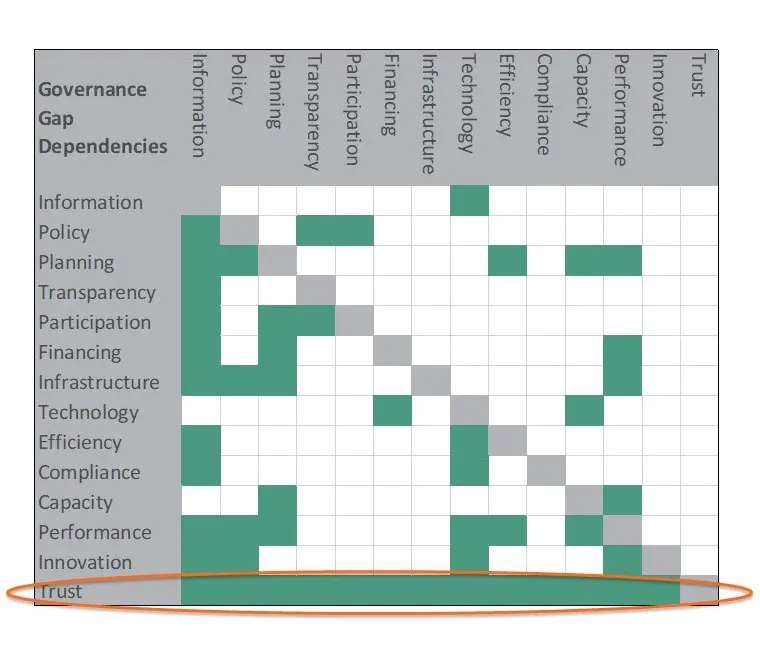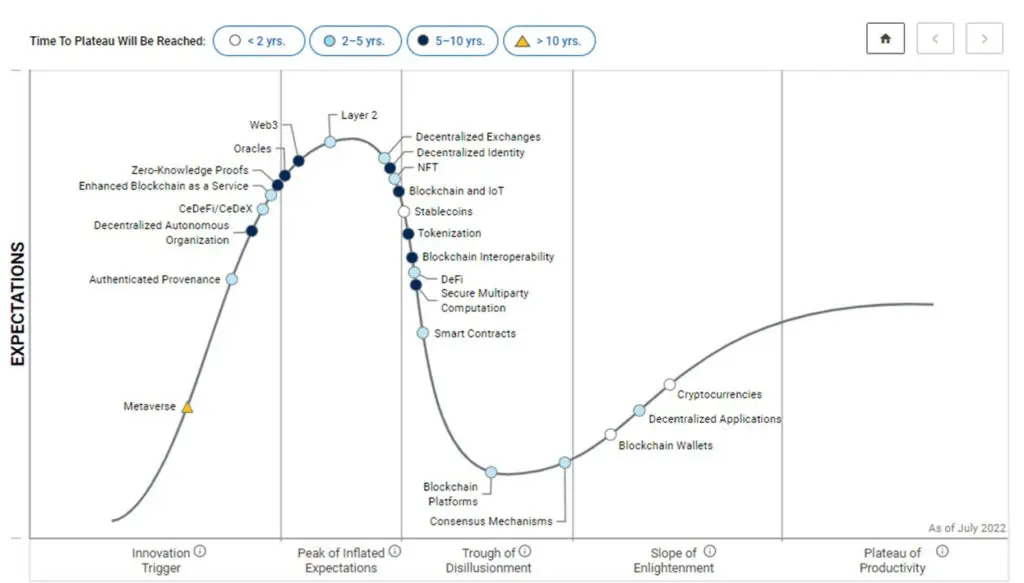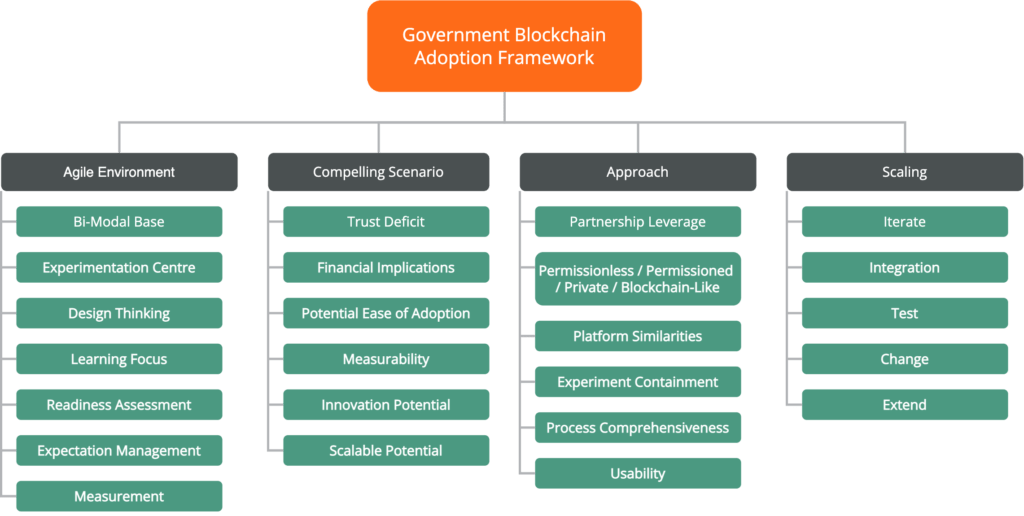Governance Gaps in Government
Governments are faced with numerous “governance gaps” which limits their ability to deliver on their mandate. Some countries have fewer gaps than others, but as our analysis shows, the gaps integrate and this network effect means that any gap ultimately leads to a trust gap.

In addition, the Edelman Trust Barometer shows that global trust in government is low. Very low.
“We find a world ensnared in a vicious cycle of distrust, fueled by a growing lack of faith in media and government. Through disinformation and division, these two institutions are feeding the cycle and exploiting it for commercial and political gain.”
The question everyone is asking: can blockchain solve this trust problem?
Can Blockchain Restore Trust in Government?
What is the promise of blockchain for government trust? In 2015, the Economist called blockchain “the trust machine.” Wired claims that blockchain “redefines trust“. And market data from financial and technology analysts suggests that the public sector is the second largest “blockchain” market after financial services.
What is Blockchain?
Blockchain is essentially technology-enabled accounting innovation that provides distributed ledgers. In other words, multiple-entry bookkeeping. Distributed ledgers mean that tech-savvy, corrupt individuals would need to manipulate hundreds of systems to commit fraud. And, these transactions are encrypted. Yet many Public Financial Management (PFM) systems don’t even have comprehensive integration among subsystems let alone distributed ledgers.
The second innovation behind blockchain: the block and the chain. The transaction lifecycle is not fully integrated in traditional accounting. Commitment accounting provides the links from commitment to obligation to contract and payment.
An ideal government Chart of Accounts includes information about the fund, or revenue source. This makes it possible to track a block of funds throughout the chain from revenue to payment transaction details, if supported in financial systems. Yet, many governments use different systems for revenue and expenditures. For example, the use of a standalone eProcurement system can obscure a part of the chain of transactions. As can separate assets, payroll, and tax administration systems. The chain is lost in sub-ledgers, interfaces, and differing metadata.
Read: The Importance of Interoperability in Government eProcurement
Blockchain links blocks, or individual transactions, in chains. Financial subsystems become integrated within chains. The linkage of chained blocks adds to transaction security. This notion of blocks and chains can enable “smart contracts” whereby transactions are approved based on “proof of work” across distributed ledgers.
Blockchain Promise and Reality
Blockchain was developed to support the trust-less environment of cryptocurrencies. Traditional financial transactions pass through trusted intermediaries like banks and governments. Public and private sector organizations have experimented with blockchain, mainly in somewhat trusted environments, such as financial settlement among banks. Nevertheless, technology analysts, the Gartner Group, sees blockchain falling in the trough of disillusionment with real adoption of blockchain not happening for at least another 2 – 10 years.

Why is Blockchain Adoption So Slow?
This is not unusual in emerging technology markets. Adoption friction includes:
- Cryptocurrency confusion: Blockchain technologies used for cryptocurrencies are not often applicable in other scenarios, and the use of cryptocurrencies for illegal or unethical financial activities taints blockchain
- Permissioned vs. permission-less: Cryptocurrencies use the permission-less approach to blockchain, while most governments should focus on permissioned and private approaches
- Performance: Blockchain performance remains poor, particularly in “permission-less” implementations that require tokens and mining
- Robustness: Bugs in any blockchain system open up the possibility of exploitation because encrypted blocks are immutable
- Numerous platforms: Numerous blockchain platforms are in use, making it difficult to determine whether to use Ethereum, Hyperledger, R3 Corda or others
Furthermore, some suggest that most blockchain initiatives do not need blockchain at all, that other mechanisms for distributing ledgers are more appropriate, or that problems can be solved by running existing software properly.
Strategic Trust Implications for Government
The three major transaction trust concerns are:
- Sin of Commission (forgery of transaction)
- Sin of Omission (censorship of transaction)
- Sin of Deletion (reversal of transaction)
For government, blockchain promises to reduce fraud and corruption, while improving controls and data reliability. Government decision makers should be less concerned about the state of blockchain adoption, or how to pick a platform. Governments need hands-on experience and experimentation is relatively low cost.
The spirit of agile development is experimentation and learning. For example, the Lean Startup methodology is all about beginning “the process of learning as quickly as possible“. It is only through controlled and inexpensive experiments that governments can make breakthrough innovation.
Government Scenarios
Here are some of the more interesting scenarios for blockchain in government:
Public Finance Scenarios
- Remittances
- Tax compliance
- Tenders and contracts
- Online payments
- Open fiscal data
- Financial audit
- Reconciliation
- Disaster relief
- Anti-money laundering
- Social benefits
- Government grants and loans
- Aid management
- Utility metering
- Government assets, facilities, property, fleet, inventory
- Government supply chain management
Other Government Scenarios
- National IDs
- Microfinance
- Central bank settlements
- Property registration
- Voting
- Records Management
- National cryptocurrencies
- Drug security
- Secure IoT
- Carbon trading
- Certificates and licenses
- Smart grid, smart energy
How Should Governments Adopt Blockchain?
Blockchain is Part of Government Digital Transformation
Government digital transformation is about governance transformation – technology-enabled governance transformation. Blockchain is a promising technology enabler, however, like any digital transformation, governments can only achieve blockchain success through modern, agile techniques.
Traditional rigid and legacy IT project management techniques should be avoided when contemplating blockchain initiatives. These techniques have proven disastrous with traditional ERP software in government. A more agile approach is required. For example, the notion of building a full business case for blockchain seems almost silly. The potential blockchain impact can be characterized, but hardly measured.
To help governments identify their readiness to adopt blockchain and design a roadmap for implementation, FreeBalance has developed an adoption framework.

Learn more about FreeBalance’s Government Blockchain Adoption Framework:
